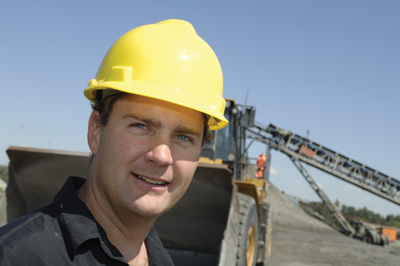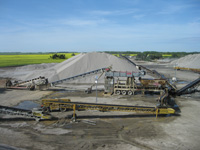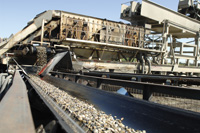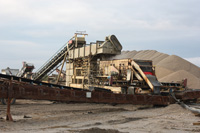
Features
Aggregates
Technology
Equipped with Armor
New screen media ends screening bottleneck for a Canadian operation.
October 18, 2010 By Rock To Road
Shielding a top-deck wire cloth scalping screen from excessive wear
means greater production efficiencies and reduced maintenance and labour
requirements – all of which deliver a lower cost of ownership and a
safer working environment for equipment owners and operators.
Shielding a top-deck wire cloth scalping screen from excessive wear means greater production efficiencies and reduced maintenance and labour requirements – all of which deliver a lower cost of ownership and a safer working environment for equipment owners and operators. That’s what an Edmonton, Alta.-based operation was seeking when challenged by weekly changeouts of conventional wire cloth media on its portable screening and washing plant. While many operations simply put up with the truths and consequences of wire cloth wear, this operation said enough is enough. It found the solution in a new screen media that combines premium wire cloth with a “molded coating” of high-grade polyurethane. It’s a combination that preserves the higher open area typical in wire cloth while extending wear life many times over.
 |
|
| Mixcor’s current president Terry Mix attributes the company’s success to strong relationships between its management, staff and customers. |
Established in 1969, Mixcor Aggregates Inc. recently celebrated its 40th anniversary and the grand opening of its new headquarters in Leduc, Alta. This second generation, family-owned and -operated company has evolved from a one-truck gravel delivery business to a major supplier of aggregate sand and gravel throughout central Alberta and the Edmonton region. Terry and Dawn Mix, along with company founders, Lorne and Tina Mix, form the family management team. Current president Terry Mix stresses that Mixcor’s continued growth is based upon nurturing ongoing relationships with its customers and more than 90 full-time employees.
Mix also values long-term relationships with his equipment suppliers. To find a solution to the maintenance bottleneck on the top deck of his three-deck six-foot by 20-foot scalping and sizing screen (wet with spray bars), he consulted with Dave Clarke, Canadian national sales manager for Linatex and its subsidiary, Durex Products. Clarke and his applications engineering team examined the screening circuit and its wear issues, while also collecting pertinent data regarding operational parameters, material characteristics and desired specifications. “They gave it the time and attention it deserved, looking at everything before coming up with a solution,” says Mix.
 |
|
| The 36-feeder is fed wash plant feed material by a WA-480-6b Komatsu loader. Before entering the log washer/blade mill, the wash plant feed goes through a pre-screener to ensure no oversized material enters the plant. |
To eliminate the downtime and labour costs associated with the frequent changeouts of conventional wire cloth, Clarke specified the new Armor™ Screen Media from Durex Products. According to Clarke, this new screen media technology offers increased open area and throughput (versus conventional urethane screens) and much longer wear life than wire screens.
Essentially, he says Durex Products has combined a premium woven wire with a molded Armor™ coating of high-grade polyurethane. “This coating is ‘molded’ to provide the advantages of relief tapered openings that increase throughput and decrease plugging. Combined with wire as a backbone, it creates an extremely high wear-resistant screen,” says Clarke.
Eventually all five six-foot by four-foot panels on the top deck were converted to Armor Screen panels during Mixcor’s 2009 season, starting with the installation of the lead panel, which takes the brunt of the 250-metric-ton-per-hour feed impact. Going into the 2010 season, Mixcor plant superintendent Kent Kasur says the original lead panel is still in operation. “We have yet to change out any screen panels and we run 24-hour shifts, five days a week for a six-month season. They all have a ton of life left in them. Our guess is that the lead panel will last at least two seasons, with the second through fifth panels lasting even longer. When operating our previous wire cloth panels, we changed out the lead panel every five days, the second and third panels every two weeks, and the fourth and fifth panels every three weeks. That meant we were changing out two or three panels each week, with an hour of downtime per panel,” says Kasur.
 |
|
| The concrete sand slurry coming out the flume under the screen deck is pumped away by an Allis Chalmers Slurry Pump. The slurry goes into a Kolberg Station Classifying Tank. Concrete and masonry sands are dewatered by 44-inch Kolberg screws.
|
Mix says the new screen panels are definitely making a big difference in operational efficiency. “As to the labour and cost savings, the math is pretty simple. We used to change out two panels per week and now we’re not changing any. There is a safety benefit as well. The more changeouts you had to do on those worn wire screens, the more opportunities for injuries from lifting or from sharp edges,” he says.
Mix also points to the fact that Durex customized the Armor Screens for optimum performance in their specific application. He explains that on the feed end of the number-one screen, the first eight inches are solid and without any openings. “This handles the impact, slows the material down and helps to distribute it evenly across the entire width of the screen panel – so that it prevents excessive wear right at the initial feed end,” he says.
While Armor Screens are available in square openings from half-inch to 1.5-inch, Mixcor’s application requires 7/8-inch openings. “The urethane is poured over the wire insert to form a true 7/8-inch opening. While you have slightly less open area than you would with conventional wire cloth, you have more than that offered by the modular urethane panels. We’re finding that we have a ton of capacity on that top deck and that small difference in open area hasn’t affected us at all,” says Mix.
If product changes would require installing different panels on the top deck, Mix says that is not a problem. “The Armor panels install just as quickly and easily as wire screen panels. It takes no longer to pop them in or out – and again, without the sharp edges, they are even easier to handle.”
 |
|
| Mix says besides safety benefits and noise reductions, the new screen panels are making a huge difference in operational efficiency. |
Lastly, Mix says that the new screen panels have delivered an added side benefit – a significant reduction in noise. “That’s a welcome alternative for several reasons. It means less exposure to noise for the crew, which is definitely a good thing. Plus it makes it easier for them to hear things, which may indicate problems in other parts of the plant. And, since we are located about a half-mile away from a residential area, it allows us to be better neighbours,” he says.
While its largest-volume material is road gravel, with asphalt and washed concrete aggregate a close second, Mixcor provides its customers with a wide range of products, from winter ice sands to riprap and ballast. “Everyone in our company is vital to our success, and we all continue to serve our customers one truckload at a time,” Mix says.
Print this page